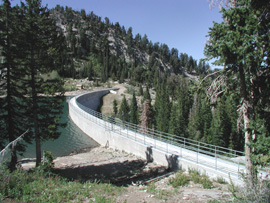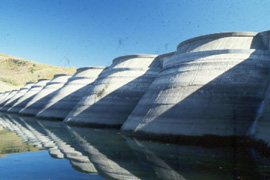Critical Water Storage
Early August water releases from local storage reservoirs help meet late summer water supply demand.
LeRoy W. Hooton, Jr.
August 13, 2001
|
|
The importance of stored water supply is borne out again this year, as northern Utah received a poor snowpack and is now experiencing a hot and dry summer. During early August 2001 water releases from Lake Phoebe-Mary in Big Cottonood Canyon and Little Dell (through Mt. Dell Reservoir) in Parleys Canyon are augmenting the municipal water supply needs of Salt Lake City's water customers.
This hydrological fact-of-life has plagued water users since the Salt Lake valley was first settled by the pioneers in 1847. The early settlers relied on direct diversions from the streams for their water supply. As time passed and the population grew, additional water was needed to protect against drought and to last longer into the growing season. The answer was water storage. Utah Lake was the first storage supply feeding the flow of the Jordan River. The earliest diversion on the Jordan River was in 1850. The first dam on the river was in 1859. The early diversions were made by farmers, conveying the water through canals to irrigation farmlands in Salt Lake County.
In 1879, Salt Lake City built the first municipal canal. The 28-mile long Jordan & Salt Lake City Canal conveyed water from the Jordan Narrows along the eastern side of the valley, terminating at Eagle Gate. At the turn of the century pumps were installed at the lake's outlet to allow more use of the storage capacity of Utah Lake.
Utah Lake water was suitable for irrigation purposes, but it was not a satisfactory drinking water supply. Beginning in 1888, Salt Lake City entered into a series of exchange agreements with the farmers who appropriated the Wasatch Canyon streams. This provided the city higher quality water for municipal use, and the farmers gained the advantage of stored water in Utah Lake to mature their crops.
The city acquired higher quality water but still faced the problem of having adequate municipal water supply to meet summer demand and protect against drought. In 1916, the city completed two small storage reservoirs at the headwaters of Big Cottonwood Canyon. Lake Phoebe-Mary and Twin Lakes dams store up to 1,600 acre-feet of water. The following year Mountain Dell Reservoir was completed. The dam would be raised 10 years later to its current 3,200 acre-foot capacity.
|
|
Deer Creek Reservoir, with a capacity of 152,000 acre-feet was completed in 1941 with water deliveries beginning in 1951. This Bureau of Reclamation project was the first large capacity reservoir built to support a large population in Salt Lake County. It was anticipated that Deer Creek would supply a population of 400,000 people. Water diversions from the Duchesne and Weber Rivers and surplus flows in the Provo River provide the water supply to fill this reservoir.
The 312,000 acre-foot Jordanelle Reservoir is the corner stone of the Bonneville Unit of the Central Utah Project. Supplied by trans-basin diversions of the Colorado River through a collection system and series of reservoirs, water is conveyed to the Wasatch Front and through exchange, stored in Jordanelle Reservoir.
All of the reservoirs store water during the spring run-off for release during the summer for irrigation and municipal uses. The larger reservoirs provide protection against drought. This year the snowpack was well below normal in most of the watersheds providing water supply to the Wasatch Front. Correspondingly, the steam flows are lower than normal. For example, the streams flow in the Upper Provo River has been reduced to a trickle at 2 cubic feet per second. Likewise, stream flows in the local canyon east of Salt Lake are only 68 percent of normal. It appears that this year will be the eleventh driest on record.
Stored water in reservoirs, both small and large, is playing an important role in providing the Wasatch Front an adequate water supply despite the drought conditions. Water managers have carefully managed the reservoirs to maximize the available water supply for the summer demand, while saving water in storage for next year. Water conserved now will stay in the reservoirs for next year's supply.
Water users have been asked to reduce by 20 percent their outdoor water usage, and to not water between 10 a.m. and 6 p.m. every day. In the event that there is another dry year, the water saved this year will help lessen the impact next year. It's to everyone’s benefit to conserve and store water in the reservoir so there is an adequate water supply next year.

